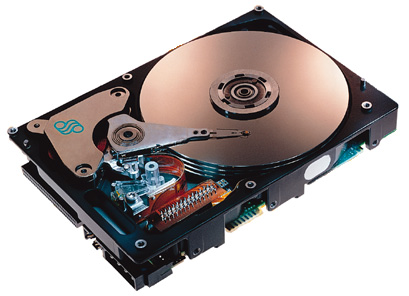Computer storage device is any of several devices for storing digital (numeric) data for use by or created by a computer. Storage devices include hard drives, CD drives, DVD drives, flash drives, and tape drives. In most cases, each of these devices can serve as both an input device, which enables a computer to use stored data, and an output device, which stores data produced on a computer. Storage devices save data on storage media, objects that can hold digital data.
Inside a computer, all data are encoded as electric charges representing the numbers 0 and 1. Storage devices store data as patterns that represent 0’s and 1’s. Many of these devices have cables and other hardware for transferring data to and from the computer. Others operate wirelessly, working with a device in the computer to send and receive information via radio signals.
A hard drive
typically stores data on one or more rigid magnetic disks, also called platters. Many people use the term hard disk to refer to the entire hard drive, but the term can also apply to an individual platter. Usually, platters are fixed inside the drive and cannot be removed. The platters are stacked on top of one another. They are coated with a magnetic recording material. Data are stored on tracks (circular bands) on each side of a platter’s surface. A hard drive has thousands of tracks. Each side of a platter has a device called a read/write head that moves in and out to specific tracks to store or to call up data for the computer to use. When the hard drive is used as an output device, the read/write head “writes” on the disk by orienting the magnetic particles in patterns representing 0’s and 1’s. As an input device, the head “reads” this pattern.
In nearly all personal computers, an internal hard drive serves as the main storage device. Usually, a computer’s storage capacity can be expanded by adding one or more internal or external hard drives. These extra drives are often used to back up (make copies of) large amounts of information stored on the main hard drive.

A CD drive
uses compact discs similar to those used to store and play music. There are several types of CD drives. A CD-ROM drive reads data from CD-ROM’s, a common means of distributing software to personal computers. The abbreviation stands for Compact Disc Read-Only Memory. The phrase read-only memory means that CD-ROM’s are permanently inscribed with their data. The computer cannot insert, change, or delete any of the data. A CD-R drive (Compact Disc-Recordable) stores data on a CD-R, a type of compact disc that can be recorded only once, and the data on it cannot then be changed or erased. A CD-RW drive (Compact Disc-ReWritable) stores data on a CD-RW, which can be recorded over and over again. A laser and light-sensitive device in a CD drive is used to “read” data from a disc. A different type of laser is used to “write” data on a recordable disc.
A DVD drive
uses DVD’s, discs that are the same size as CD’s but store much more data. A DVD stores data on one or both sides. A DVD-ROM drive reads DVD-ROM’s, which, like CD-ROM’s, are permanently inscribed. Other types of DVD drives store data on recordable or rewritable DVD’s. DVD drives can also read regular music CD’s and CD-ROM’s. Like CD drives, DVD drives use lasers and light-sensitive devices in the “reading” and “writing” processes.
A flash drive
stores data using special memory chips called flash memory chips, flash disks, or solid-state drives. These chips can typically be “written on” and erased more than 100,000 times. The chips do not lose data when they are disconnected from a power source. Flash drives are completely electronic and have no moving parts. They are self-contained units and can be smaller than a fingertip.
Some flash drives can be plugged into a port in most computers. They are often used to back up data or transport data between computers. A common type of flash device is the small removable card that stores the pictures taken by a digital camera. Flash devices are also used as the main storage device in a variety of other electronic products, including portable media players, mobile phones, and certain newer computers.
A tape drive
stores data sequentially on magnetic tape in much the same way as an audiotape recorder stores sound information. Tape drives copy data much more slowly than do disk drives. However, they are extremely reliable and have an especially large storage capacity. For these reasons, tape drives are often used to make complete copies of large storehouses of digital data. For example, a major corporation might use a tape drive to back up the data in all of its computer systems. Databases stored on tape are vital for preserving records and for restoring data in the event of a disaster or computer failure.
